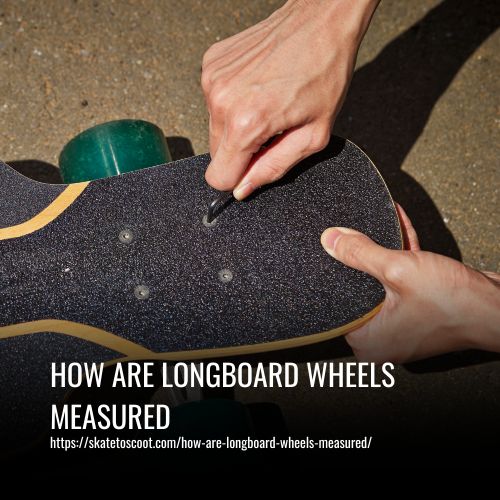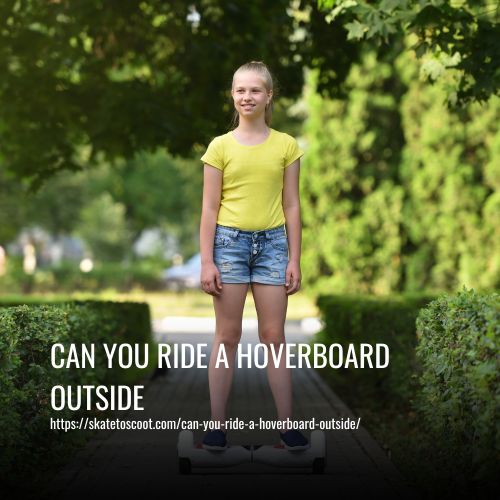As an Amazon Associate we earn from qualifying purchases.
Wheel size is measured in diameter, typically ranging from 60mm to 75mm or more. Larger wheels provide a smoother ride over rough surfaces and offer more speed for downhill riding. Smaller wheels, on the other hand, are preferred for freeride and flip tricks due to their quick acceleration.
Durometer refers to the hardness of the wheel, which is measured using a scale from 78A to 101A. Harder wheels (85A and above) are ideal for sliding and riding on rougher surfaces, while softer wheels (78A to 84A) offer more grip and a smoother ride on smooth surfaces.
The various measurements are discussed below:
- Durometer Measurement.
- Width Measurement.
- Contact Patch Measurement.
- Lip Profile Measurement.

How Are Longboard Wheels Measured?
Longboard wheels are measured using several key dimensions, each of which plays a vital role in determining their performance on different terrains and riding styles. Understanding these measurements is crucial for optimizing your ride and tailoring it to your specific needs.
The size of longboard wheels is typically measured by their diameter. Larger wheels provide a smoother ride and excel on rough surfaces, making them ideal for downhill riding. Smaller wheels, on the other hand, offer quick acceleration and increased maneuverability, making them suitable for technical tricks.
1. Diameter Measurement:
The diameter of longboard wheels refers to their overall size, usually measured in millimeters. This measurement is crucial as it directly affects the performance and compatibility of the wheels with different terrains.
Larger wheel diameters provide several advantages. They offer higher top speeds and better momentum retention, making them ideal for downhill racing and faster rides. With larger wheels, riders can maintain stability and control even at high speeds.
Smaller wheel diameters, on the other hand, have their benefits. They provide quicker acceleration and increased maneuverability, which is advantageous for performing technical tricks and navigating through crowded urban areas.
2. Width Measurement:
When measuring longboard wheels, one important aspect to consider is the width of the wheel. The width refers to the distance between the inner edges of the contact patch, which is the part of the wheel that makes contact with the ground. This measurement is usually expressed in millimeters.
The width of a wheel plays a crucial role in determining the traction and slide control of the longboard. Wider wheels generally offer more grip because they have a larger contact patch with the ground. This increased surface area provides greater stability and control, making wider wheels a good choice for riders who prioritize these factors.
3. Contact Patch Measurement:
The contact patch of a longboard wheel is the area of the wheel that makes contact with the ground while riding. This measurement is crucial as it directly affects the grip and traction of the wheel.
A larger contact patch provides more surface area, resulting in increased grip. This is beneficial for riders who engage in carving and downhill racing, where stability and control are paramount. The larger contact patch allows for a more secure connection to the ground, enhancing grip and reducing the risk of sliding out.
Conversely, a smaller contact patch offers less grip and traction. This makes it easier to initiate slides and perform maneuvers in tricks and slides. Riders who prioritize smooth slides and maneuverability, such as freestyle riders, prefer wheels with smaller contact patches.
4. Lip Profile Measurement:
The lip profile of a longboard wheel plays a crucial role in determining its performance during slides and grip while cornering. It refers to the shape of the wheel’s outer edge.
Sharp-edged lips provide increased grip, making them suitable for high-speed turns and racing. These wheels maintain a strong connection with the pavement, allowing riders to confidently maneuver through corners. The sharp lip profile ensures stability and enhances traction, enabling riders to maintain control even at high speeds.
On the other hand, rounded lips allow for smoother slides, making them ideal for freeriding and technical tricks. These wheels offer less resistance against the pavement, enabling riders to initiate slides more easily. The rounded lip profile promotes a smooth and predictable sliding motion, allowing riders to execute precise maneuvers and tricks.
The Importance of Longboard Wheel Measurement
Proper longboard wheel measurement is essential for achieving optimal performance and ride quality. One crucial factor to consider is wheel hardness, which is measured on the durometer scale. Harder wheels (higher durometer rating) are ideal for smooth surfaces and downhill riding, providing maximum grip and quick acceleration.
Larger wheels provide a smoother ride, especially on rough terrains, while smaller wheels offer better maneuverability, making them suitable for flip tricks and tight turns. Measuring and selecting the right longboard wheels based on hardness and size ensures a balanced ride, enhancing overall control and enjoyment.
Conversely, smaller wheels offer quick acceleration and increased maneuverability, making them ideal for technical tricks and street riding. These wheels are also lighter and more responsive, allowing for easier maneuvering in tight spaces.
Exploring Common Wheel Sizes and Their Applications:
When selecting the right longboard wheels for a particular riding style, terrain, and performance needs, it’s important to consider the common wheel sizes available. There are several popular longboard wheel sizes, each offering its own benefits depending on the rider’s needs. Popular sizes include 69mm wheels, 70mm wheels, 72mm
1. 60-65mm Wheels: Perfect for Tricks and Maneuverability:
- These smaller wheels, ranging from 60-65mm, are highly popular among freestyle riders and beginners.
- Designed for street and park skating, they offer enhanced maneuverability and quick acceleration.
- The smaller size allows riders to perform tricks and slides with ease, making them ideal for freestyle riding.
2. 66-75mm Wheels: Balancing Speed and Versatility:
- Falling into the mid-range, these wheels (66-75mm) strike a balance between street and downhill riding.
- They provide moderate speed and stability, making them suitable for various terrains and riding styles.
- These wheels are versatile enough to handle both tricks and downhill rides, offering a well-rounded riding experience.
3. 76-85mm Wheels: High Speeds and Long-Distance Cruising:
- Larger wheels within the 76-85mm range are the top choice for downhill racers and enthusiasts who enjoy long-distance cruising.
- With their larger size, they ensure higher top speeds and excellent stability, allowing riders to maintain momentum on long stretches.
- Perfect for downhill racing or cruising along open roads, these wheels provide riders with an exhilarating and comfortable ride.
4. 86mm+ Wheels: Maximum Speed and Control for Downhill Specialists:
- Reserved for downhill specialists, these gigantic wheels, 86mm or larger, offer the ultimate in speed and control.
- These wheels are specifically designed for intense downhill runs, providing riders with the confidence to tackle steep descents.
- They prioritize stability and control, allowing riders to maintain their line and handle high speeds with ease.
By understanding the different wheel sizes and their applications, riders can choose the right measurements to suit their preferred riding style, whether it’s freestyle tricks, downhill racing, or long-distance cruising.
How Pro Riders Customize Wheel Measurements for Their Needs:
Professional longboarders customize their wheel measurements to suit their riding style and the specific demands of their discipline. They carefully consider the diameter, durometer, width, and lip profile of their wheels to optimize performance.
For technical freestyle riding, smaller diameter wheels are preferred as they allow for quick spins and rapid tricks. On the other hand, larger-diameter wheels are chosen for downhill racing to provide stability and speed during high-speed descents.
The width of the wheel’s contact patch also plays an important role. Narrow contact patches enhance slide control, making them ideal for freestyle and technical tricks. On the other hand, wider contact patches offer improved grip, which is beneficial for downhill and carving enthusiasts.
FAQs
Longboard wheels are measured in millimeters (mm) for their diameter. This measurement is taken from the outer edge of the wheel across its center to the opposite outer edge. This diameter measurement determines the size of the wheel.
The numbers represent the diameter of the wheel in millimeters. For instance, a wheel labeled as 70mm has a diameter of 70 millimeters from one outer edge across the center to the other outer edge.
The size of the wheel impacts various aspects of longboarding, including speed, stability, acceleration, and maneuverability. Larger wheels typically offer higher speeds and smoother rides, while smaller wheels provide better control and acceleration.
Yes, besides diameter, durometer (hardness) is another crucial measurement. Durometer is measured in an “A” scale, indicating the hardness or softness of the wheel. A higher durometer number means a harder wheel, offering greater durability and speed, while a lower durometer number signifies a softer wheel, providing better grip and shock absorption.
Consider the type of riding you prefer. For downhill and high-speed riding, larger wheels (70mm+) with a higher durometer (78A+) are suitable. For freestyle, cruising, or tricks, smaller wheels (60mm-70mm) with a slightly softer durometer (75A-85A) may be preferred for better maneuverability and grip.
Yes, the width of the wheel also impacts performance. Wider wheels generally offer more stability, especially in turns, while narrower wheels might feel more responsive and agile. Ensure the width complements your riding style and the deck’s compatibility to achieve optimal performance.
Conclusion:
Understanding how longboard wheels are measured is crucial for any rider looking to customize their ride and enhance their performance. By considering factors such as diameter, durometer, and shape, you can find the perfect wheels to match your riding style and preferences.
So, get out there, measure up, and hit the pavement with confidence, knowing that you’ve got the right wheels to take you on an epic journey!
Amazon and the Amazon logo are trademarks of Amazon.com, Inc, or its affiliates.


